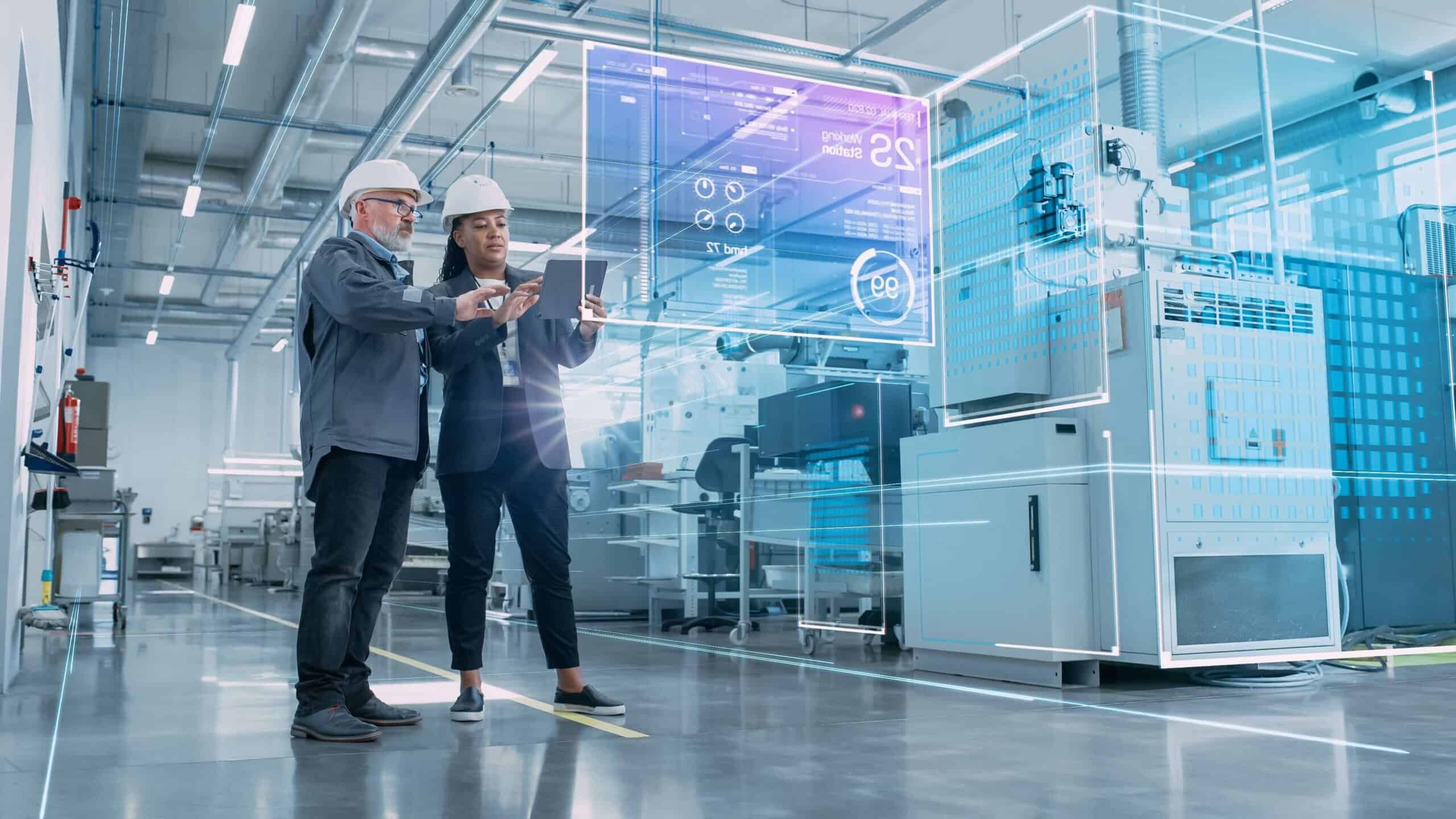- Improving the efficiency of the risk response process
- Minimising equipment downtime with predictive maintenance
- More accurate demand forecasting
- Streamlining contract negotiations
- Reducing environmental impact
The global supply chain is a complex network of interconnected processes involving innumerable entities, stakeholders, resources, and technologies. As businesses navigate the challenges of an increasingly globalised and competitive marketplace, they must contend with a myriad of obstacles, including outdated processes, rising costs, geopolitical disruptions, and increasingly stringent sustainability regulations. The ever-changing nature of consumer demands and market dynamics creates additional complexity, putting supply chain operators in a position where continuous adaptation and innovation are essential.
In the face of these challenges, artificial intelligence (AI) has emerged as a promising solution that has the potential to revolutionise supply chain management. Among the most exciting developments in this field is generative AI, a subset of AI that focuses on creating new content, designs, and solutions based on existing data. By embracing generative AI, businesses can optimise their supply chain operations, streamline processes, and uncover valuable insights that drive informed decision-making.
While much of the public’s attention has been directed towards consumer-facing AI applications, such as chatbots that assist with tasks like composing emails or offering personal advice, the true potential of generative AI lies in its ability to transform complex systems like supply chains. Forward-thinking organisations have already recognised the value of this technology, with a January 2024 EY study revealing that approximately 40 per cent of supply chain companies are actively investing in generative AI solutions. By integrating generative AI into their operations, these businesses are positioning themselves to overcome the obstacles posed by an increasingly demanding and unpredictable global market, ultimately achieving resilience in the face of uncertainty—not to mention a boost to efficiency and customer satisfaction.
“The generative AI—the email, communications and business contexts—allows us to really expedite that mitigation and the engagement with the suppliers”.
Ray Smith, vice president of supply chain, business applications, and platforms at Microsoft
Improving the efficiency of the risk response process
The global marketplace has become more and more volatile in recent years, and supply chain disruptions have become an increasingly common occurrence. Because of this, businesses have been forced to turn to innovative risk management processes and techniques and integrate them into their overarching supply chain strategies. Generative AI technology has proven particularly effective in this regard. Its models excel at detecting patterns and analysing vast quantities of information, making them invaluable assets for supply chain professionals seeking to reduce risk.
By analysing data from a wide range of sources, such as historical records, market trends, meteorological data, and geopolitical events, these models can provide businesses with a comprehensive understanding of their strengths and weaknesses, allowing them to proactively address areas of concern and fortify their operations against potential disruptions. Furthermore, generative AI can also generate detailed risk assessment reports, conduct realistic scenario simulations, and devise tailored mitigation strategies, providing supply chain managers with a dynamic, data-driven framework for navigating the complexities of the modern business landscape. Moreover, generative AI’s user-friendly conversational interfaces can streamline the risk mitigation process, enabling swift and effective communication between stakeholders and fostering a culture of collaboration and adaptability.
For example, Microsoft recently upgraded its existing supply chain management platform with the addition of a new AI-powered feature called Dynamics 365 Copilot, which uses generative AI to monitor a wide range of risk factors, from adverse weather conditions to geopolitical instability, and generate predictive insights that can help supply chain managers stay ahead of the curve. When the AI system identifies a potential risk, it can automatically draft personalised emails to relevant stakeholders, inquiring about anticipated disruptions and confirming the status of critical orders. This seamless, AI-driven communication loop enables businesses to respond swiftly and effectively to emerging threats, minimising the impact of disruptions on their operations. “A lot of people in the supply chain would say they don’t have time … to look at dashboards if there’s potential data there, let alone engage the suppliers in something that potentially may happen”, explains Ray Smith, vice president of supply chain, business applications, and platforms at Microsoft. “Generative AI—the email, communications and business contexts—allows us to really expedite that mitigation and the engagement with the suppliers”.
Minimising equipment downtime with predictive maintenance
Another area where generative AI can offer meaningful assistance is predictive maintenance. By continuously monitoring and analysing a broad range of parameters, such as vibration levels, temperature fluctuations, and acoustic patterns, generative AI models can develop a deep understanding of the unique inner workings of each piece of equipment. This intimate knowledge allows the model to detect even the most subtle anomalies and deviations from normal operating conditions, serving as an early warning system for potential failures. With this foresight at their disposal, businesses can bid farewell to the reactive, fire-fighting approach to maintenance that has long plagued the industry. Instead, they can embrace a more proactive strategy where maintenance interventions are precisely timed to coincide with the predicted onset of equipment degradation. This approach would not only minimise unplanned downtime and its associated costs but also extend the lifespan of valuable assets.
Siemens announced in February 2024 that its existing predictive maintenance solution, Senseye Predictive Maintenance, will be gaining a new generative AI functionality, bringing a new level of flexibility and insight to its customers. By facilitating a seamless, interactive dialogue between users, AI, and maintenance experts, this interactive platform streamlines the decision-making process, enabling faster and more effective problem-solving. The new generative AI functionality within the platform can scan and group cases across multiple languages, drawing upon past experiences and solutions to provide invaluable context for current challenges. This contextual awareness ensures that maintenance teams have access to the right information at the right time, empowering them to make informed decisions and take proactive measures to prevent downtime. One of the key strengths of Senseye Predictive Maintenance’s generative AI functionality is its ability to break down data silos and process information from a wide range of maintenance software. This enables the platform to paint a holistic picture of the manufacturing environment, uncovering hidden patterns and insights that might otherwise go unnoticed. By leveraging this wealth of data, the platform can generate prescriptive maintenance strategies that are tailored to the unique needs of each organisation, taking into account factors such as equipment history, operating conditions, and maintenance protocols.
More accurate demand forecasting
The ability to accurately predict and respond to fluctuations in demand is a critical factor in determining a company’s success. As businesses grapple with the complexities of global markets, the limitations of traditional forecasting methods have become increasingly apparent, leaving organisations vulnerable to unexpected shifts and disruptions. However, the recent emergence of generative AI promises to change the way companies approach demand planning dramatically. By leveraging this powerful technology, supply chain managers can gain a deeper understanding of the complex web of factors that influence demand, from seasonal trends and market shifts to consumer preferences and economic indicators. Armed with this knowledge, businesses can develop more accurate and responsive forecasting models, enabling them to anticipate and adapt to changes in demand with greater ease and precision.
SymphonyAI, a leading provider of AI-powered supply chain solutions, recently unveiled a new generative AI tool called Demand Planner Copilot, which will be integrated directly into the company’s existing Demand Forecasting platform. This innovative solution empowers supply chain professionals to tackle complex problems and make informed decisions faster than ever before, delivering improved forecast accuracy and freeing up valuable time and resources. The Demand Planner Copilot employs a conversational interface that allows users to interact with the system in a more intuitive and natural way. Rather than navigating complex dashboards and reports, supply chain managers can simply ask questions and receive actionable insights in return. Whether it’s identifying significant changes in forecasted volume, recommending product links for new item introductions, or analysing unexpected discrepancies between actual and projected demand, the Copilot acts as a virtual assistant, guiding users through the complexities of demand planning and helping them focus on the most critical issues at hand.
“Our AI actually brings a human touch to [contract] negotiations”.
Martin Rand, CEO of Pactum
Streamlining contract negotiations
Contracts play a vital role in facilitating transactions and defining relationships between companies and their partners. However, the complex language and intricate terms often found in these agreements can make it challenging for businesses to fully comprehend and leverage their contractual obligations. This not only hinders the effective utilisation of contracts but also poses potential risks and can lead to missed opportunities. One of the primary obstacles to realising the full potential of contracts lies in their inherent ambiguity. Legal jargon and imprecise language can lead to differing interpretations, creating uncertainty about how to proceed and creating an avenue for potential disputes. Companies will often manage a vast portfolio of such contracts, each with its own set of terms and conditions, and often through a range of different countries’ legal systems. Navigating through this labyrinth of agreements and understanding how they interact with one another can be a daunting task, even for experienced legal professionals.
Fortunately, recent advancements in generative AI offer a promising solution to these challenges. By employing sophisticated software algorithms, generative AI can extract valuable insights from legal documents, making them more accessible and understandable. Natural Language Processing (NLP) techniques enable AI systems to analyse the language within contracts, highlighting key details and providing a comprehensive overview of a company’s legal obligations and rights. Furthermore, generative AI has the potential to change the way companies approach contract creation and negotiation. By leveraging AI-powered tools, businesses can significantly streamline the authoring process, reducing the time and effort required to draft and review contracts. Additionally, AI can assist in identifying potential risks and opportunities during negotiations, empowering companies to make informed decisions and achieve more favourable outcomes.
For instance, global shipping and logistics firm Maersk has implemented an AI-based system called Pactum to automate commercial negotiations at scale. By utilising a user-friendly chat interface, Pactum’s AI negotiator engages with suppliers, aligning their values and objectives to reach mutually beneficial agreements. This approach not only saves time and resources but also brings a personalised touch to negotiations, fostering stronger relationships with vendors. “People often point out that negotiations are by nature fluid, and how can you replicate this using AI? But the truth is only about 20 per cent of negotiations are like this. The rest of negotiations are very one-sided because 80 per cent of vendors are non-strategic, and at the moment, procurement professionals don’t have enough time to deal with them”, explains Martin Rand, CEO of Pactum. “Our AI actually brings a human touch to these negotiations because the system reaches out to suppliers. It asks on behalf of the company how it can help them grow and what benefits it can bring them. Such attention is simply not possible in a big enterprise”.
Reducing environmental impact
For centuries, the maritime sector has served as the backbone of the world economy, connecting distant lands and facilitating the exchange of goods and resources. However, this vital industry has also come at a significant cost to the planet, contributing to greenhouse gas emissions, air and water pollution, and the degradation of marine ecosystems. As the world becomes increasingly aware of the urgent need to address climate change and protect the environment, the shipping industry faces mounting pressure to reduce its carbon footprint and adopt more sustainable practices. In response to these challenges, international organisations and governments have implemented various regulations and initiatives aimed at promoting green shipping. Complying with these environmental regulations while simultaneously meeting the growing demand for faster transportation of goods and maintaining profitability goals poses a monumental challenge for the shipping industry.
To help navigate this multifaceted landscape, artificial intelligence startup Bearing AI recently launched the Deployment Planner, a cutting-edge AI tool designed to help shipping companies optimise their operations to meet environmental compliance standards while achieving commercial objectives. By leveraging historical data, current operational parameters, and future projections, the Deployment Planner offers a range of features to enhance fleet efficiency and reduce emissions. One of the key capabilities of the Deployment Planner is its ability to recommend changes in deployment that will ensure optimal efficiency. For example, it can recommend rotating vessels between high- and low-emission routes to maintain fleet compliance. This intelligent allocation of resources helps shipping companies minimise their environmental impact without compromising on operational performance.
Furthermore, the AI-powered tool can identify various inefficiencies, such as underperforming vessels and schedules, proposing alternative solutions that can help companies remain compliant with emissions regulations. By highlighting areas of inefficiency and offering data-driven recommendations, the Deployment Planner enables shipping companies to make informed decisions that optimise their operations while adhering to environmental regulations. Another noteworthy feature of the Deployment Planner is its ability to simulate how fuel consumption and vessel performance respond to changes in service schedules. This allows liners to quickly identify the most cost-effective and emissions-efficient deployments, taking into account a wide range of variables and potential scenarios.
At the heart of Bearing AI’s technology are advanced deep-learning models that analyse multiple variables and calculate millions of potential combinations in real time. These models generate precise predictions on emissions, fuel costs, fleet performance, and other critical metrics, empowering vessel operators to make data-driven decisions that support both commercial and sustainability goals. “Environmental compliance is just one component in an increasingly complex balancing act for the marine shipping industry”, says Kristofer Maanum, senior product leader at Bearing AI. “When making adjustments to address emissions, modern shipping companies need to be able to see the impact on their operations, and vice versa—and they need to do it in real-time across millions of variables. This level of scenario simulation is only possible with AI. Our vision is to not only ease the industry’s transition towards green shipping but also enable it to harness AI to make confident decisions that support commercial and sustainability goals”.
Closing thoughts
As the global supply chain continues to evolve and adapt to the challenges of an increasingly complex and interconnected world, the integration of generative AI into supply chain management processes presents a transformative opportunity. By leveraging this cutting-edge technology, businesses can revolutionise their approach to risk management, predictive maintenance, demand forecasting, and environmental sustainability, unlocking unprecedented levels of efficiency, adaptability, and resilience. The potential applications of generative AI in supply chain management are vast and far-reaching, ranging from proactive risk mitigation and optimised maintenance strategies to highly accurate demand forecasting and dynamic contract negotiations.
With more organisations recognising the strategic value of generative AI in supply chain management, the adoption of these technologies is set to accelerate rapidly in the coming years. By embracing the power of AI-driven insights and decision-making, businesses can position themselves at the forefront of the digital transformation sweeping across the supply chain landscape. The successful integration of generative AI into supply chain processes will not only drive operational excellence but also foster a culture of innovation, collaboration, and continuous improvement, ensuring that organisations remain agile and competitive in the face of ever-evolving market dynamics.




